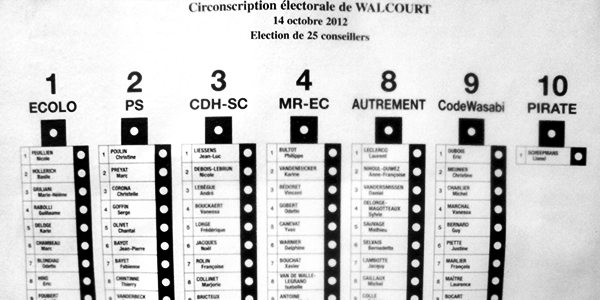Choosing winning candidates in proportional systems does not increase voter satisfaction
Does expressing a preference for winning candidates as well as voting for a political party improve electoral satisfaction? Damien Bol and his colleagues test whether flexible-list PR improves voter satisfaction using the case of Belgium, and finds that – contrary to expectation – voting for winning candidates does not increase voters’ satisfaction with electoral outcomes compared with ‘party-list’ voters.

Ballot Paper, Belgium. Picture Lionel Scheepmans via a CC BY-SA 3.0 licence/Wikimedia Commons
There is a large agreement among political observers to say that satisfaction should be greater when voters have more influence over the final electoral outcome. Yet cross-national studies find mixed evidence of this claim. It is crucial, therefore, to turn to individual-level data and single-country studies. We cannot assume that the type of electoral system affects all citizens equally. There can be important differences depending on individual voters’ behaviour.
In a recent paper, we analyse data from Belgium to give news insights to this topic. Belgium uses a typical flexible proportional representation (PR) system with optional preference voting for candidates. Voters first decide for which party they want to vote, and then choose to either vote for individual candidates (preference voters) or validate the entire party-list without voting for any candidate (party-list voters). As in most flexible-list PR systems, the seats are allocated between candidates depending on both the number of preference votes received and their rank order on the party-list.
In 2014, we conducted an original panel survey during the weeks before and after the federal election. We compared levels of satisfaction of party-list voters on the one hand, and preference voters on the other. Our variable of interest is the difference in satisfaction before and after the election. In our survey, we also asked respondents to report exactly how they voted using mock ballots. The use of mock ballots in post-election surveys increases the accuracy of reported voting behaviour. We can thus be confident about the vote choice variables we used.
In a first series of analysis, we found that party-list voters are the most satisfied after controlling for variables like party choice and socio-demographic characteristics. On a scale from -10 (much less satisfied after than before the election) to +10 (much more satisfied after than before the election), they are more satisfied by 0.26 (see Table 1). They are more satisfied than both preference voters who voted for multiple non-elected candidates (-0.17), and preference voters who voted for multiple winning candidates (+0.11). Although the differences are small, this is still an unexpected result.
Table 1: Predicted levels of satisfaction before and after election
| Type of voters | Difference in satisfaction |
|---|---|
| Voting for at least 2 individual candidates elected | +0.11 |
| Voting for at least 2 individual candidates non-elected | -0.17 |
| Party-list voters | +0.26 |
Note: Predicted values based on OLS regression. Control variables include party vote, age, gender, education and number of preference votes. These control variables are kept at their mean to calculate the predictions.
In a second series of analysis, we compared the level of satisfaction of preference voters depending on the overall number of preference votes received by the candidates for whom they voted. In flexible-list PR systems like the one used in Belgium, the preference score is an important popularity test with direct implications. Political parties use the scores in preference votes as a crucial element for determining the post-election career of candidates. The preference votes for an individual candidate functions as a primary system, which allows voters to choose future members of the government. Although respondents did not know which parties will form the governing coalition when we fielded the post-election survey, they knew the preference score of the most popular candidates as it is widely commented on in the media immediately after the election.
Figure 1 shows the predicted difference in satisfaction before and after the election for preference voters as a function of the preference score of the candidate for which they voted who got the best score, after controlling for party choice and socio-demographics. We find that the predicted value goes from -0.27 to +0.47. The dashed lines in the figure gives a more realistic range, as it is the -1 to +1 standard deviation around the mean of the variable preference score. The predicted value between these two points goes from -0.18 to +0.20. It is interesting to note that the predicted satisfaction of preference voters who vote for a candidate with a high preference score (=mean+1 standard deviation) is still lower than the predicted satisfaction of party-list voters (+0.26 see above).
Figure 1: Predicted levels of satisfaction before and after the election for preference voters

Note: Predicted values based on OLS regression. Control variables include party vote, age, gender, education, number of preference votes, number of elected and non-elected candidates for whom they voted. These control variables are kept at their mean to calculate the predictions.
In our study, we show voting for non-elected candidates negatively affects satisfaction in a flexible-list PR system. Voting for elected candidates can by contrast boost satisfaction, but only when this vote is for one of the most popular candidates. Yet, even for them the boost is similar to that of party-list voters. Our findings thus cast doubt on the hypothesis that open- or flexible-list PR systems can re-connect critical citizens with representative democracy and elections.
This post represents the views of the author and not those of Democratic Audit.
For more details on the study, see: Damien Bol, André Blais, Xavier Gillard, Lidia Nunez, and Jean-Benoit Pilet (2018) Voting and Satisfaction with Democracy in Flexible-List PR. Electoral Studies 56: 23–34.
About the author
 Damien Bol is an Assistant Professor in the Department of Political Economy of King’s College London. His research lies at the intersection of political behaviour and comparative politics, with a special focus on political institutions and elections. His work appears in Comparative Political Studies, Political Science Research and Methods, and the European Journal of Political Research (among others).
Damien Bol is an Assistant Professor in the Department of Political Economy of King’s College London. His research lies at the intersection of political behaviour and comparative politics, with a special focus on political institutions and elections. His work appears in Comparative Political Studies, Political Science Research and Methods, and the European Journal of Political Research (among others).





 Democratic Audit's core funding is provided by the Joseph Rowntree Charitable Trust. Additional funding is provided by the London School of Economics.
Democratic Audit's core funding is provided by the Joseph Rowntree Charitable Trust. Additional funding is provided by the London School of Economics.